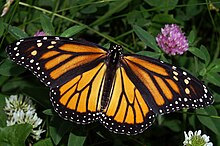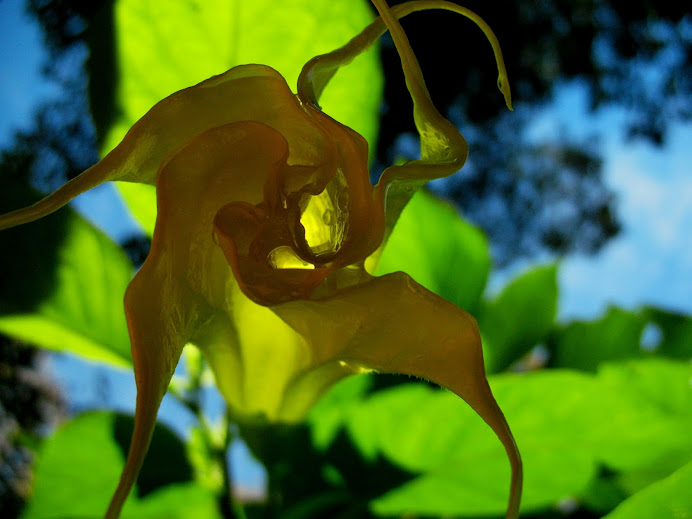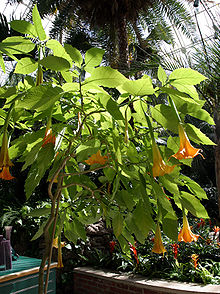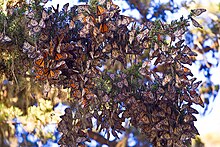
Hi Everybody!!
Tonight in the States was Super Bowl Sunday, a football game. I do not participate in Television, so watching was not in my game plan. I spent the time reading news about the Monarch Migration, reported to be the least amount of Monarchs in Mexico ever. Below is shared info from Wikipedia on these beautiful butterflies. Also, a photostudy on the Grand Opening of an Angel Trumpet Bud in my yard. As for the flying butter, we all know butter does not fly!
Enjoy Your Week!

Alarming news about Monarchs at following link:
http://www.ibtimes.com/monarch-butterfly-grave-danger-disappearing-migration-reaches-record-low-1552802
https://en.wikipedia.org/wiki/Monarch_butterfly
Monarch butterfly
From Wikipedia, the free encyclopedia
| Monarch butterfly | |
|---|---|
 | |
| Female Monarch | |
 | |
| Male Monarch | |
| Conservation status | |
| Scientific classification | |
| Kingdom: | Animalia |
| Phylum: | Arthropoda |
| Class: | Insecta |
| Order: | Lepidoptera |
| Family: | Nymphalidae |
| Tribe: | Danaini |
| Genus: | Danaus Kluk, 1780 |
| Species: | D. plexippus |
| Binomial name | |
| Danaus plexippus (Linnaeus, 1758) | |
 | |
| Synonyms | |
The Monarch butterfly (Danaus plexippus) is a milkweed butterfly (subfamily Danainae) in the family Nymphalidae. It is perhaps the best known of all North American butterflies. Since the 19th century, it has been found in New Zealand, and in Australia since 1871, where it is called the wanderer.[3][4][5] It is resident in the Canary Islands, the Azores, andMadeira, and is found as an occasional migrant in Western Europe and a rare migrant in the United Kingdom.[6] Its wings feature an easily recognizable orange and black pattern, with a wingspan of 8.9–10.2 cm (3½–4 in).[7] (The viceroy butterfly is similar in color and pattern, but is markedly smaller, and has an extra black stripe across the hind wing.) Female monarchs have darker veins on their wings, and the males have a spot called theandroconium in the center of each hind wing.[8] Males are also slightly larger than female monarchs. The Queen is a close relative.
The monarch is famous for its southward late summer/autumn migration from the United States and southern Canada to Mexico and coastal California, and northward return in spring, which occurs over the lifespans of three to four generations of the butterfly. The migration route was fully determined by Canadian entomologists Fred and Norah Urquhartafter a 38-year search, aided by naturalists Kenneth C. Brugger and Catalina Trail who solved the final piece of the puzzle by identifying the butterflies' overwintering sites in Mexico. The discovery has been called the "entomological discovery of the 20th century".[9] An IMAX film, Flight of the Butterflies, tells the story of the long search by the Urquharts, Brugger and Trail to unlock the secret of the butterflies' migration.[10] There is evidence that eastern North American populations of the monarch butterfly migrate to south Florida and Cuba.[11]
Migration[edit]
Monarchs are especially noted for their yearly migration over long distances. In North America they make massive southward migrations starting in August until the first frost. There is a northward migration in the spring.[28] The monarch is the only North American butterfly that migrates both north and south as the birds do regularly, but no individual makes the entire round trip. Female monarchs lay eggs for the next generation during these migrations.[29] Painted Ladies also make a return migration from Africa to Northern Europe [30]
By the end of October, the population east of the Rocky Mountains migrates to thesanctuaries of the Mariposa Monarca Biosphere Reserve within the Trans-Mexican Volcanic Belt pine-oak forests in the Mexican states of Michoacán and México. The western population overwinters in various coastal sites in central and southern California,United States, notably in Pacific Grove, Santa Cruz, and Grover Beach.
The length of these journeys exceeds the normal lifespan of most monarchs, which is less than two months for butterflies born in early summer. The last generation of the summer enters into a nonreproductive phase known as diapause, which may last seven months or more.[8] During diapause, butterflies fly to one of many overwintering sites. The overwintering generation generally does not reproduce until it leaves the overwintering site sometime in February and March.
The overwintered population of those east of the Rockies may reach as far north as Texasand Oklahoma during the spring migration. The second, third and fourth generations return to their northern locations in the United States and Canada in the spring. How the species manages to return to the same overwintering spots over a gap of several generations is still a subject of research; the flight patterns appear to be inherited, based on a combination of the position of the sun in the sky[31] and a time-compensated Sun compass that depends upon a circadian clock based in their antennae.[32][33] New research has also shown these butterflies can use the earth's magnetic field for orientation. The antennae containcryptochrome, a photoreceptor protein sensitive to the violet-blue part of the spectrum. In presence of violet or blue light, it can function as a chemical compass, which tells the animal if it is aligned with the earth's magnetic field, but it cannot tell the difference between magnetic north or south. The complete magnetic sense is present in a single antenna.[34][35]
Monarch butterflies are one of the few insects that can cross the Atlantic. They are becoming more common in Bermuda, due to increased use of milkweed as an ornamental plant in flower gardens. Monarch butterflies born in Bermuda remain year round due to the island's mild climate. A few monarchs turn up in the far southwest of Great Britain in years when the wind conditions are right, and have been seen as far east as Long Bennington in Lincolnshire. In Australia, monarchs make limited migrations in cooler areas,[3] but the blue tiger butterfly is better known in Australia for its lengthy migration.[4]Monarchs can also be found in New Zealand. On the islands of Hawaii, no migrations have been noted.
Monarch butterflies are poisonous or distasteful to birds and mammals because of the presence of the cardiac glycosides contained in milkweed eaten by the larvae. The bright colors of larvae and adults are thought to function as warning colors. During hibernation, monarch butterflies sometimes suffer losses because hungry birds pick through them looking for the butterflies with the least amount of poison, but in the process kill those they reject.
One study examined wing colors of migrating monarchs using computer image analysis, and found migrants had darker orange (reddish-colored) wings than breeding monarchs.[36]
Research also has overturned a prevailing theory that the migration patterns of the eastern and western populations are due to genetic reasons and that their genetic material was different. The American populations have been found to be distinct from the populations inNew Zealand and Hawaii, but not from each other.[37]
**Grand Opening**



The Angel's Trumpet Bud Opening at Sunset
link to photostudy in G+Albums:
https://plus.google.com/u/0/photos/117645114459863049265/albums/5701663346618496593


https://en.wikipedia.org/wiki/Brugmansia
Brugmansia
From Wikipedia, the free encyclopedia
| Brugmansia | |
|---|---|
 | |
| Brugmansia 'Feingold' | |
| Scientific classification | |
| Kingdom: | Plantae |
| (unranked): | Angiosperms |
| (unranked): | Eudicots |
| (unranked): | Asterids |
| Order: | Solanales |
| Family: | Solanaceae |
| Subfamily: | Solanoideae |
| Tribe: | Datureae |
| Genus: | Brugmansia Pers. |



...this is brendasue signing off from Rainbow Creek. See You next time!


O+O






No comments:
Post a Comment
Hi Everybody! Please say hello and follow so I know you are here! Due to the inconsideration of people trying to put commercials on my blog comment area, I have restricted use of anonymous posts. Sorry that some hurt all.
My public email is katescabin@gmail.com No spammers or trolls